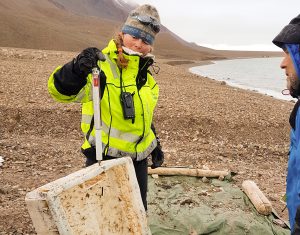
When I started getting involved with plastic a few years ago, I was still a novelty on the scene. Most people were not even aware of the problem. Fortunately, that has today now changed. I am so glad that I did not let myself get dissuaded in my fight against plastic waste in the early days – because it is truly wonderful how much interest the project and I now get, how much support I get and what wonderful people I have encountered as a result. This makes me so happy! And this is why the next stage is now coming: I am starting a series about plastic because I am constantly being asked the same questions: What alternatives are there to plastic? What can I do and do alone? What exactly is the deal with microplastics, with glass versus plastic bottles or with sewage treatment plants in Germany? In this series I’ll show you what I’ve changed in my life myself – you can just copy it and save yourself the hassle of searching for solutions. It is much easier (and often cheaper) than you think!
I will report on plastic waste and plastic avoidance in bulk, with practical tips and lots of information – because you can only change something if you have knowledge about it. In this first text, I therefore first clarify some basic questions about plastic waste and why we urgently need to change something.
What is the problem with plastic waste?
The plastic problem can easily be reduced to the combination of three individual factors – and it is only because these three factors coincide that plastic really becomes a problem. In the search for solutions, this means that if only one of these factors could be eliminated, the problem would be largely solved. These factors are:
- Plastic lasts – it takes about 450 years for a PET bottle to break down.
- Plastic is everywhere – even in the Central Arctic and in the almost 11,000 meter deep Mariana Trench.
- Plastic is toxic – it contains and absorbs toxins that accumulate in the food chain.
If you could replace plastic with a substance that decomposes faster OR if you could significantly reduce or eliminate the plastic input into our eco systems OR if you could produce a plastic without harmful substances – then the problem would no longer be that which we have today.
How much plastic is there?
In 1950 only 1.5 million tons of plastic were produced worldwide each year. Mass production of plastics began in the 1950s; It took off very slowly in the beginning, but then grew faster and faster. In 2015 we had an annual production of 381 million tons. What is interesting here is the rapid growth in plastic production since the turn of the millennium: in the 13 years from 2002 to 2015 we produced as much plastic as we did in the 52 years from 1950 to 2002.And production continues to grow.
From the start of production to 2016, around 8,300 million tons of plastic have been produced.
How much garbage does this create?
Annual garbage figures are difficult to determine because longer-lasting materials continue to flow unrecorded into the garbage stockpile. As a result, plastic production in 2010 amounted to 270 million tons worldwide, but the amount of plastic waste amounted to 275 million tons worldwide (because the plastic from earlier years flowed into the waste stream).
How much garbage is in our oceans today is difficult to say. There are now many scientific studies that attempt to calculate this figure, but all of these studies extrapolate the garbage quantities from individual counts and therefore have considerable uncertainties. That is why research teams have chosen a different approach and, based on production data, calculated how much plastic waste is generated worldwide each year and how much of it ends up in the sea. However, this figure cannot be clearly defined either, the researchers assume it to be 4.8 to 12.7 million tons per year.
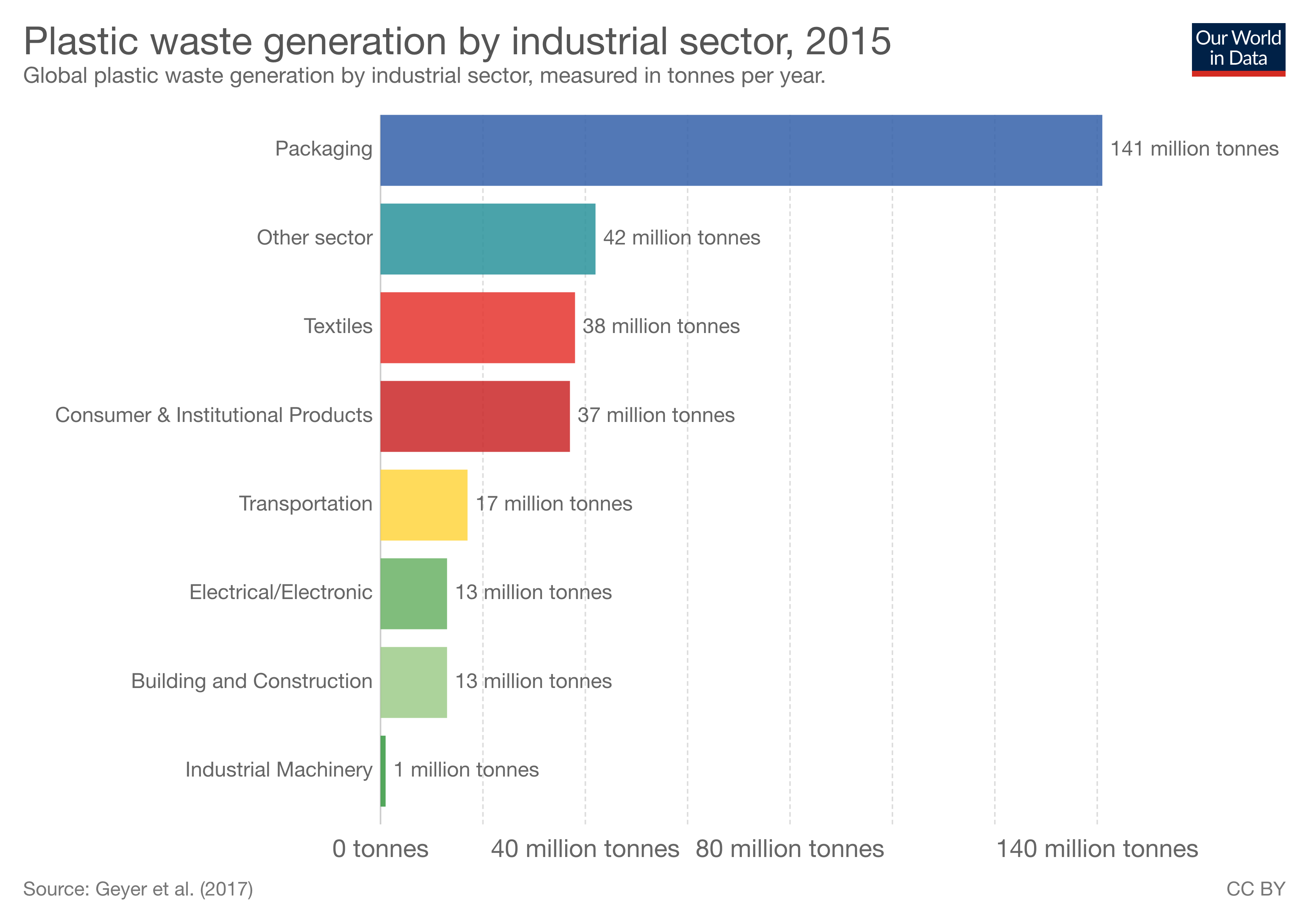
The amount of waste has continued to grow since 2016, and distribution across the individual sectors has remained roughly the same: packaging is the dominant factor, followed by construction. However, since packaging has a much shorter cycle of use than products from the construction or textile industry, packaging also dominates with regard to the volume of waste. Packaging accounts for almost half of global plastic waste.
Was ist mit Fischernetzen?
It is estimated that about 80 percent of marine litter comes from land-based sources and 20 percent from sources at sea. The fishing industry dominates here and is responsible for lost or discarded nets, ropes and waste, as well as abandoned ships. The proportion of waste sources varies significantly depending on the location, currents, population and activities in the area. In Svalbard, for example, the proportion of fishing waste is significantly higher, while elsewhere household waste dominates.
In one study, the World Food Organization returns two terrifying figures: 25,000 nets have been lost in European waters, a total of around 1250 kilometres of net in Europe alone. This has clear consequences for marine life, for mammals such as whales, seals and dolphins, as well as for seabirds that get tangled and perish in the nets. More than 800 marine species have now been shown to be affected by plastic. Fishing nets are long-living – it can take up to 600 years for such a net to decompose. Then, however, it is still present as microplastic and enters the food chain.
But plastic can be recycled,can´t it?
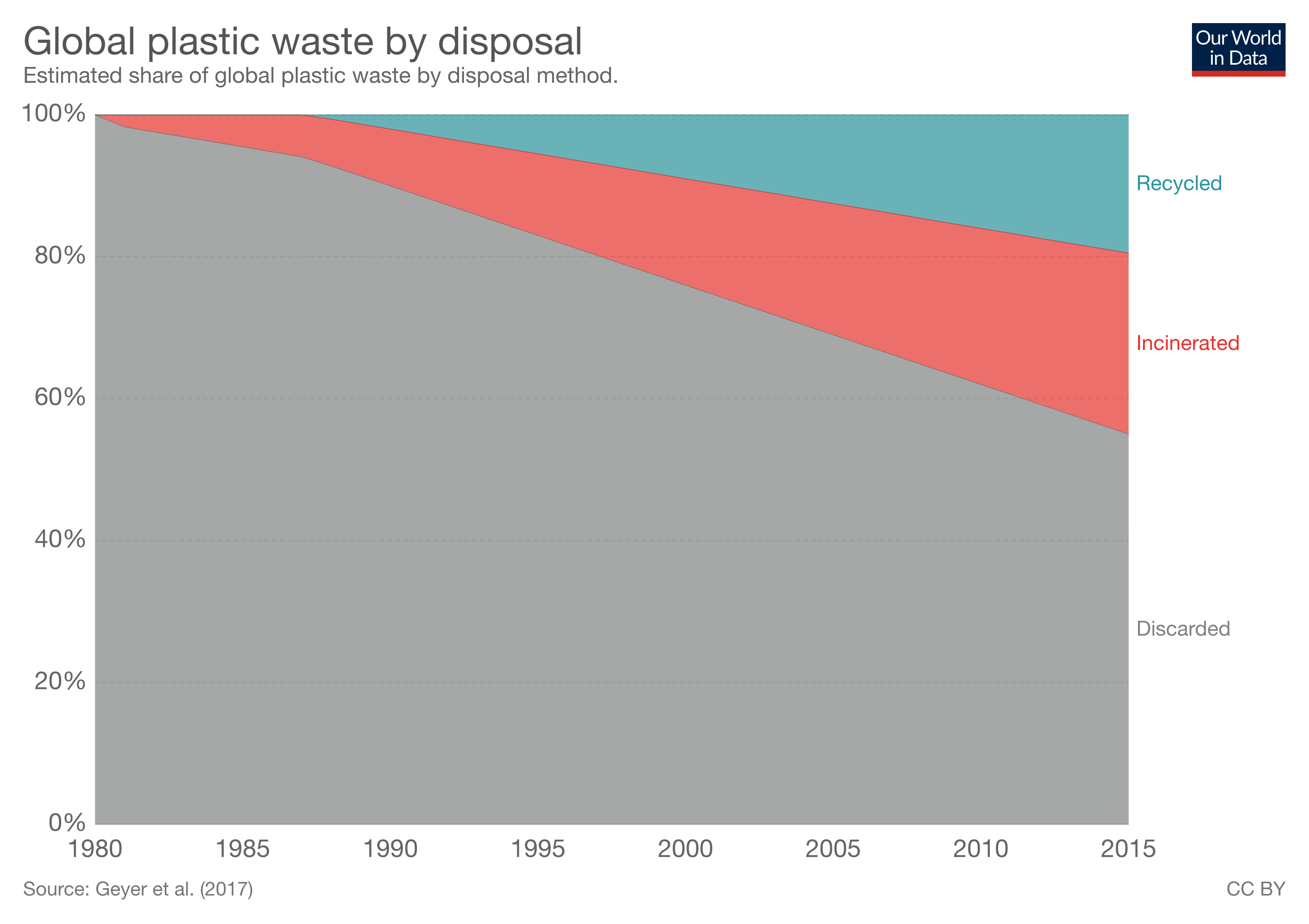
Recycling would be a sensible way to deal with plastic that has already been produced. Currently, 55 percent of the global amount of waste ends up in landfills, 25 percent is incinerated and 20 percent is recycled. Of the plastic waste created between 1950 and 2015, only nine percent was recycled, 91 percent landfilled or incinerated.
But here in Germany we are better, right? Everything here gets recycled.
Die Antwort ist einfach: Nein.
The answer is simple: no.
In 2016, a total of 18.2 million tons of packaging waste was generated in Germany. That is 220.5 kilos per capita, 53 kilos more than the EU average of 167.3 kilos.
The share of recycling by all EU countries in 2015 was as follows:
- Slovenia 63%
- Czech Republic 63%
- Bulgaria 61%
- Netherlands 51%
- Germany 49%
- Sweden 49%
- Spain 44%
- EU total 40%
- Austria 34%
- France 25%
- Finland 24%
Germany, together with Sweden, is only in 5th place here, less than half of the plastic waste is recycled. In addition, these figures are often criticised for being embellished because plastic is often introduced into the recycling process, but then cannot be recycled and as a result simply gets incinerated. In the statistics, however, it still appears as having been recycled.
Negative development for reusable bottles
The increase in the annual amount of packaging waste in Germany can be attributed to several factors (more single households and packaging in portions, higher GDP and thus more consumption, more mail order business). The packaging of beverages also constitutes a substantial share: from 2007 to 2016, the proportion of reusable bottles fell from 51.2 to 42.8 percent, and disposable packaging rose from 45.4 to 55.8 percent. Anyone who had hoped for an increase in ecologically sound disposable packaging will also be disappointed here: This proportion has decreased from 3.4 to 1.4 percent.
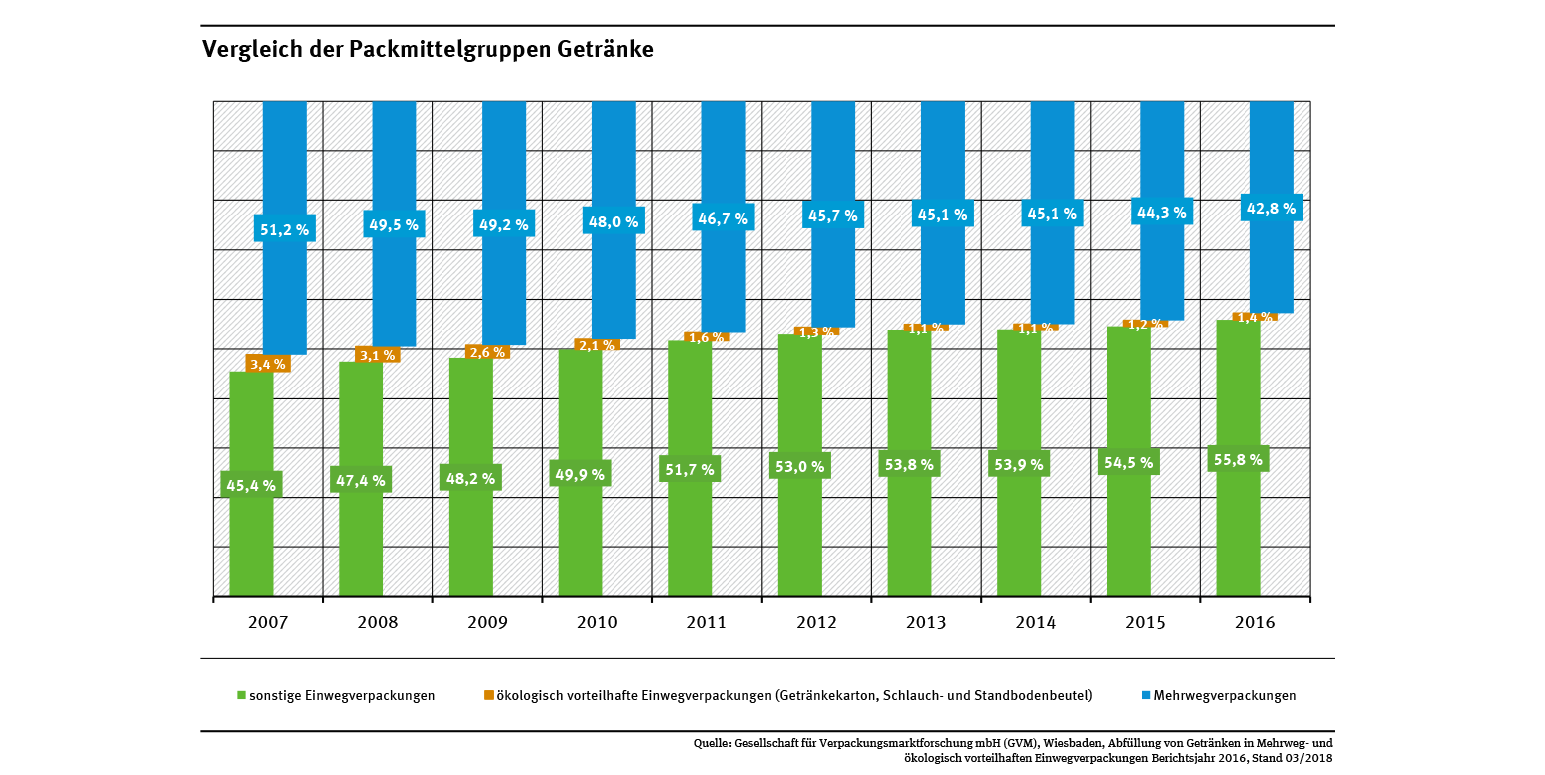
German plastic bag consumption has decreased in the meantime – but 2.4 billion plastic bags (excluding the fruit and garbage bags) are still being used every year in Germany alone. That is 29 bags per head.
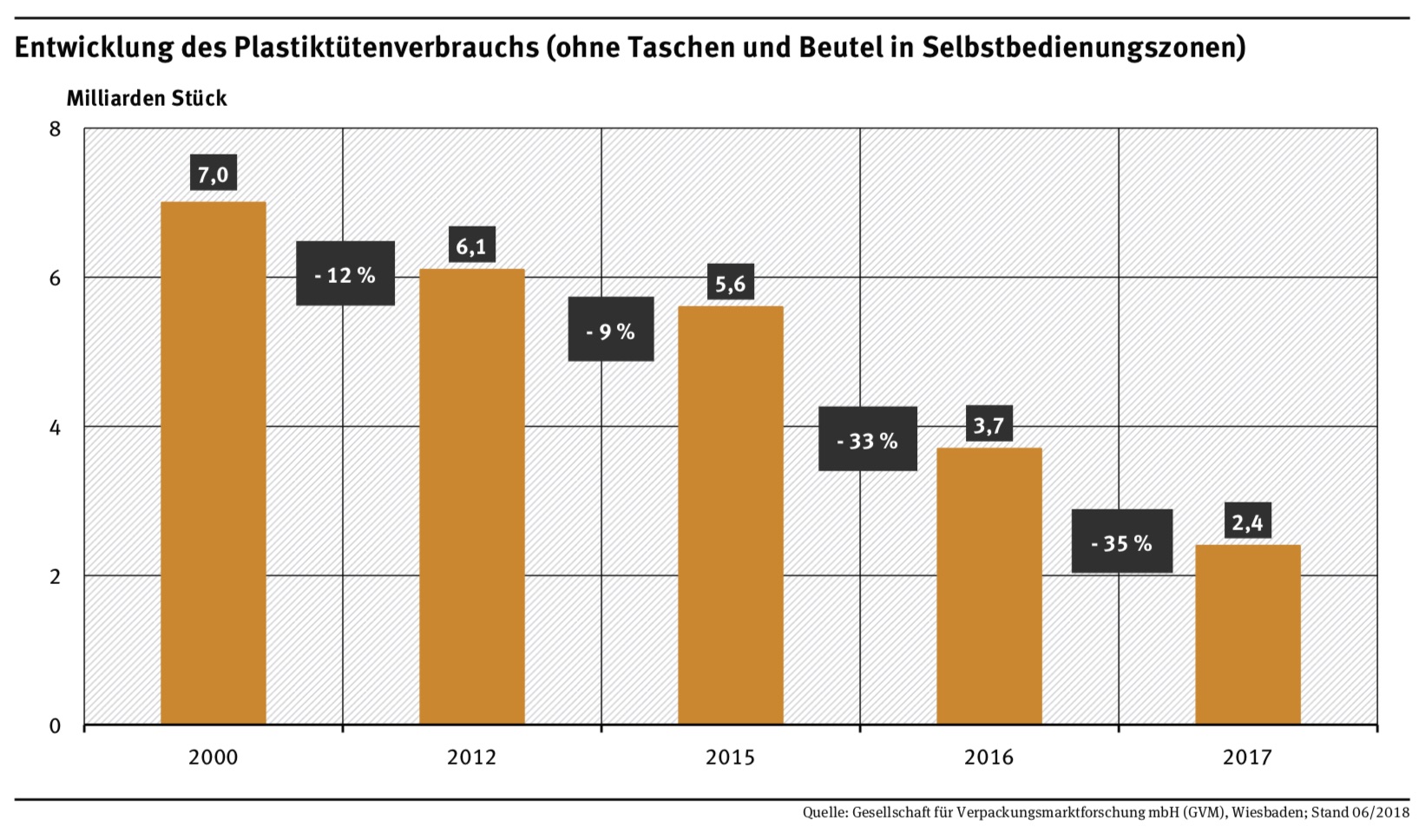 A look to the future
A look to the future
If we continue on the path we have chosen so far, if we continue to use this much and more plastic, and continue to replace other materials with plastic, experts give the following forecast: In 2050, 1124 million tons of waste will be produced worldwide. Year for year.That would mean more plastic than fish in our oceans.
Lots of figures -what now?
These figures are necessary to illustrate how big our problem is now. But other problems have been addressed and resolved in the past. I am thinking of CFCs here – a negative development that was able to be stopped. The decisive factor with CFCs were state bans that were agreed internationally. Unfortunately, a number of case studies from the United Nations Environment Program (UNEP) show that government bans or fees are the only effective measures when it comes to positive developments in the waste sector. To this end, UNEP 2018 examined a whole series of measures that have already been taken worldwide. The sobering conclusion: voluntary-based programmes have had little success. On the other hand, very simple measures such as the introduction of a PlasTax on plastic bags in Ireland had astonishing success: the share of plastic bags in the total amount of waste in Ireland fell from 4.8 to 0.22 percent within a year, and per capita consumption fell from 328 on 21 bags.
Decisive action by politicians is required to take effective measures against the plastic flood and, if necessary, to issue bans.
What we also need are innovations, smart products that reflect the 2019 state of technology and knowledge. Environmental friendliness and sustainability need not go hand in hand with sacrifice and self-mortification. At the same time, it must not be left to the responsibility of consumers to make consumption as environmentally friendly as possible through time-consuming research and efforts. We are entitled to and must demand products that automatically meet the maxim that is actually self-explanatory: That they do not unduly harm our world.
What we therefore need is the development of alternatives: substances that offer the same advantages as the existing plastics, but that are less harmful to the environment. Research and development in such projects must be promoted, while products that damage all of our living space must be contained: disposable bottles, Nespresso capsules, coffee-to-go cups – these are products of the past millennium. They are not innovative, they are not attractive, they make inappropriate use of resources and generate levels of waste that cannot be overlooked – and that therefore pose an undeniable threat. In future, those responsible, the manufacturers, must be held responsible for this damage.
It’s a long way to go, but a start has been made. And we can do a lot ourselves until the government and manufacturers finally step up to the task. Everyone creates their own little mountain of garbage in the course of their life. How big it is in the end is up to each individual. The sum of our individual actions ultimately leads to the statistics shown above. The behaviour of the individual is not irrelevant.
Since I began focussing on plastic waste in the household, I’ve been surprised at how simple some things are – and also how much cheaper.
In the following weeks, I will introduce you, in a very simple way, to ways that can help you to reduce your garbage mountain yourself.
The most important thing is that you start with something. We don’t need a vanishing minority who live a perfect zero-waste life. We need a huge majority who try it imperfectly, and take it forward step by step.
Sources:
Our world in data: Plastic Pollution
Plastics Europe: Plastics – the Facts 2018
Business Insider: Erschreckende Studie: Innerhalb von 13 Jahren haben wir die Hälfte des weltweiten Plastiks produziert
AWI: Müll im Meer
Deutsche Welle: Das passiert mit dem deutschen Müll
Umweltbundesamt: Verpackungsabfälle, Packmittelgruppe Getränke
United Nations Environment Programme: A Roadmap for Sustainability
